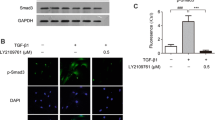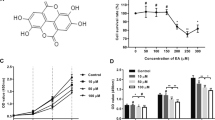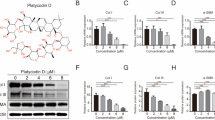Abstract
Hypertrophic scar (HS) is characterized by excessive fibrosis associated with aberrant function of fibroblasts. Currently, no satisfactory drug has been developed to treat the disease. Here we found that a flavonoid natural product, galangin, could significantly attenuate hypertrophic scar formation in a mechanical load-induced mouse model. Both in vivo and in vitro studies demonstrated that galangin remarkably inhibited collagen production, proliferation, and activation of fibroblasts. Besides, galangin suppressed the contractile ability of hypertrophic scar fibroblasts. Further Western blot analysis revealed that galangin dose-dependently down-regulated Smad2 and Smad3 phosphorylation. Such bioactivity of galangin resulted from its selective targeting to the activin receptor-like kinase 5 (ALK5) was demonstrated by ALK5 knockdown and over-expression experiments. Taken together, this compound could simultaneously inhibit both the accumulation of collagen and abnormal activation/proliferation of fibroblasts, which were the two pivotal factors for hypertrophic scar formation, thus suggesting that galangin serves as a potential agent for treatment of HS or other fibroproliferative disorders.





Similar content being viewed by others
Change history
06 March 2020
In the original article, Figs.��3b, 4a, c and 5d were published incorrectly. The correct version of the figures are provided in this correction.
06 March 2020
In the original article, Figs.��3b, 4a, c and 5d were published incorrectly. The correct version of the figures are provided in this correction.
References
van den Broek LJ, Limandjaja GC, Niessen FB, Gibbs S (2014) Human hypertrophic and keloid scar models: principles, limitations and future challenges from a tissue engineering perspective. Exp Dermatol 23:382–386. doi:10.1111/exd.12419
Zielins ER, Atashroo DA, Maan ZN, Duscher D, Walmsley GG, Hu M, Senarath-Yapa K, McArdle A, Tevlin R, Wearda T, Paik KJ, Duldulao C, Hong WX, Gurtner GC, Longaker MT (2014) Wound healing: an update. Regen Med 9:817–830. doi:10.2217/rme.14.54
Rabello FB, Souza CD, Farina Junior JA (2014) Update on hypertrophic scar treatment. Clinics (Sao Paulo) 69:565–573
Vrijman C, van Drooge AM, Limpens J, Bos JD, van der Veen JP, Spuls PI, Wolkerstorfer A (2011) Laser and intense pulsed light therapy for the treatment of hypertrophic scars: a systematic review. Br J Dermatol 165:934–942. doi:10.1111/j.1365-2133.2011.10492.x
Profyris C, Tziotzios C, Do Vale I (2012) Cutaneous scarring: pathophysiology, molecular mechanisms, and scar reduction therapeutics: part I. The molecular basis of scar formation. J Am Acad Dermatol 66:1–10. doi:10.1016/j.jaad.2011.05.055
Zhu Z, Ding J, Shankowsky HA, Tredget EE (2013) The molecular mechanism of hypertrophic scar. J Cell Commun Signal 7:239–252. doi:10.1007/s12079-013-0195-5
Gurtner GC, Werner S, Barrandon Y, Longaker MT (2008) Wound repair and regeneration. Nature 453:314–321. doi:10.1038/nature07039
Darby IA, Laverdet B, Bonte F, Desmouliere A (2014) Fibroblasts and myofibroblasts in wound healing. Clin Cosmet Investig Dermatol 7:301–311. doi:10.2147/ccid.s50046
Wong VW, Rustad KC, Akaishi S, Sorkin M, Glotzbach JP, Januszyk M, Nelson ER, Levi K, Paterno J, Vial IN, Kuang AA, Longaker MT, Gurtner GC (2012) Focal adhesion kinase links mechanical force to skin fibrosis via inflammatory signaling. Nat Med 18:148–152. doi:10.1038/nm.2574
Santos EO, Kabeya LM, Figueiredo-Rinhel AS, Marchi LF, Andrade MF, Piatesi F, Paoliello-Paschoalato AB, Azzolini AE, Lucisano-Valim YM (2014) Flavonols modulate the effector functions of healthy individuals’ immune complex-stimulated neutrophils: a therapeutic perspective for rheumatoid arthritis. Int Immunopharmacol 21:102–111. doi:10.1016/j.intimp.2014.04.014
Kumar S, Alagawadi KR (2013) Anti-obesity effects of galangin, a pancreatic lipase inhibitor in cafeteria diet fed female rats. Pharm Biol 51:607–613. doi:10.3109/13880209.2012.757327
Chien ST, Shi MD, Lee YC, Te CC, Shih YW (2015) Galangin, a novel dietary flavonoid, attenuates metastatic feature via PKC/ERK signaling pathway in TPA-treated liver cancer HepG2 cells. Cancer Cell Int 15:15. doi:10.1186/s12935-015-0168-2
Li S, Wu C, Zhu L, Gao J, Fang J, Li D, Fu M, Liang R, Wang L, Cheng M, Yang H (2012) By improving regional cortical blood flow, attenuating mitochondrial dysfunction and sequential apoptosis galangin acts as a potential neuroprotective agent after acute ischemic stroke. Molecules 17:13403–13423. doi:10.3390/molecules171113403
Madduma Hewage SR, Piao MJ, Kim KC, Cha JW, Han X, Choi YH, Chae S, Hyun JW (2015) Galangin (3,5,7-trihydroxyflavone) shields human keratinocytes from ultraviolet B-induced oxidative stress. Biomol Ther (Seoul) 23:165–173. doi:10.4062/biomolther.2014.130
Choi JK, Kim SH (2014) Inhibitory effect of galangin on atopic dermatitis-like skin lesions. Food Chem Toxicol 68:135–141. doi:10.1016/j.fct.2014.03.021
Wang X, Gong G, Yang W, Li Y, Jiang M, Li L (2013) Antifibrotic activity of galangin, a novel function evaluated in animal liver fibrosis model. Environ Toxicol Pharmacol 36:288–295. doi:10.1016/j.etap.2013.04.004
Kosla J, Dvorak M, Cermak V (2013) Molecular analysis of the TGF-beta controlled gene expression program in chicken embryo dermal myofibroblasts. Gene 513:90–100. doi:10.1016/j.gene.2012.10.069
Woeller CF, O’Loughlin CW, Roztocil E, Feldon SE, Phipps RP (2015) Salinomycin and other polyether ionophores are a new class of antiscarring agent. J Biol Chem 290:3563–3575. doi:10.1074/jbc.M114.601872
Nakao A, Imamura T, Souchelnytskyi S, Kawabata M, Ishisaki A, Oeda E, Tamaki K, Hanai J, Heldin CH, Miyazono K, ten Dijke P (1997) TGF-beta receptor-mediated signalling through Smad2, Smad3 and Smad4. EMBO J 16:5353–5362. doi:10.1093/emboj/16.17.5353
Aarabi S, Bhatt KA, Shi Y, Paterno J, Chang EI, Loh SA, Holmes JW, Longaker MT, Yee H, Gurtner GC (2007) Mechanical load initiates hypertrophic scar formation through decreased cellular apoptosis. FASEB J 21:3250–3261. doi:10.1096/fj.07-8218com
Hinz B (2007) Formation and function of the myofibroblast during tissue repair. J Investig Dermatol 127:526–537. doi:10.1038/sj.jid.5700613
Wynn TA, Ramalingam TR (2012) Mechanisms of fibrosis: therapeutic translation for fibrotic disease. Nat Med 18:1028–1040. doi:10.1038/nm.2807
Hayashi H, Abdollah S, Qiu Y, Cai J, Xu YY, Grinnell BW, Richardson MA, Topper JN, Gimbrone MA Jr, Wrana JL, Falb D (1997) The MAD-related protein Smad7 associates with the TGFbeta receptor and functions as an antagonist of TGFbeta signaling. Cell 89:1165–1173
Heldin CH, Miyazono K, ten Dijke P (1997) TGF-beta signalling from cell membrane to nucleus through SMAD proteins. Nature 390:465–471. doi:10.1038/37284
Liu XJ, Xu MJ, Fan ST, Wu Z, Li J, Yang XM, Wang YH, Xu J, Zhang ZG (2013) Xiamenmycin attenuates hypertrophic scars by suppressing local inflammation and the effects of mechanical stress. J Investig Dermatol 133:1351–1360. doi:10.1038/jid.2012.486
Ledon JA, Savas J, Franca K, Chacon A, Nouri K (2013) Intralesional treatment for keloids and hypertrophic scars: a review. Dermatol Surg 39:1745–1757. doi:10.1111/dsu.12346
Leventhal D, Furr M, Reiter D (2006) Treatment of keloids and hypertrophic scars: a meta-analysis and review of the literature. Arch Facial Plast Surg 8:362–368. doi:10.1001/archfaci.8.6.362
English RS, Shenefelt PD (1999) Keloids and hypertrophic scars. Dermatol Surg 25:631–638
Gauglitz GG, Korting HC, Pavicic T, Ruzicka T, Jeschke MG (2011) Hypertrophic scarring and keloids: pathomechanisms and current and emerging treatment strategies. Mol Med 17:113–125. doi:10.2119/molmed.2009.00153
Desmouliere A, Chaponnier C, Gabbiani G (2005) Tissue repair, contraction, and the myofibroblast. Wound Repair Regen 13:7–12. doi:10.1111/j.1067-1927.2005.130102.x
Gellibert F, Woolven J, Fouchet MH, Mathews N, Goodland H, Lovegrove V, Laroze A, Nguyen VL, Sautet S, Wang R, Janson C, Smith W, Krysa G, Boullay V, De Gouville AC, Huet S, Hartley D (2004) Identification of 1,5-naphthyridine derivatives as a novel series of potent and selective TGF-beta type I receptor inhibitors. J Med Chem 47:4494–4506. doi:10.1021/jm0400247
Sapitro J, Dunmire JJ, Scott SE, Sutariya V, Geldenhuys WJ, Hewit M, Yue BY, Nakamura H (2010) Suppression of transforming growth factor-beta effects in rabbit subconjunctival fibroblasts by activin receptor-like kinase 5 inhibitor. Mol Vis 16:1880–1892
Shen N, Lin H, Wu T, Wang D, Wang W, Xie H, Zhang J, Feng Z (2013) Inhibition of TGF-beta1-receptor posttranslational core fucosylation attenuates rat renal interstitial fibrosis. Kidney Int 84:64–77. doi:10.1038/ki.2013.82
Higashiyama H, Yoshimoto D, Kaise T, Matsubara S, Fujiwara M, Kikkawa H, Asano S, Kinoshita M (2007) Inhibition of activin receptor-like kinase 5 attenuates bleomycin-induced pulmonary fibrosis. Exp Mol Pathol 83:39–46. doi:10.1016/j.yexmp.2006.12.003
Park JH, Ryu SH, Choi EK, Ahn SD, Park E, Choi KC, Lee SW (2015) SKI2162, an inhibitor of the TGF-beta type I receptor (ALK5), inhibits radiation-induced fibrosis in mice. Oncotarget 6:4171–4179
Shang Y, Yu D, Hao L (2015) Liposome–adenoviral hTERT-siRNA knockdown in fibroblasts from keloids reduce telomere length and fibroblast growth. Cell Biochem Biophys. doi:10.1007/s12013-014-0476-5
Wang YW, Liou NH, Cherng JH, Chang SJ, Ma KH, Fu E, Liu JC, Dai NT (2014) siRNA-targeting transforming growth factor-beta type I receptor reduces wound scarring and extracellular matrix deposition of scar tissue. J Investig Dermatol 134:2016–2025. doi:10.1038/jid.2014.84
Aoki M, Miyake K, Ogawa R, Dohi T, Akaishi S, Hyakusoku H, Shimada T (2014) siRNA knockdown of tissue inhibitor of metalloproteinase-1 in keloid fibroblasts leads to degradation of collagen type I. J Investig Dermatol 134:818–826. doi:10.1038/jid.2013.396
Dehshahri A, Sadeghpour H (2015) Surface decorations of poly(amidoamine) dendrimer by various pendant moieties for improved delivery of nucleic acid materials. Colloids Surf B Biointerfaces 132:85–102. doi:10.1016/j.colsurfb.2015.05.006
Acknowledgments
This study was supported by grants from the key project of the National Natural Science Foundation (No. 81230042) and the National Key Project of Scientific and Technical Supporting Programs Funded by Ministry of Science & Technology of China (No. 2012BAI11B03).
Author information
Authors and Affiliations
Corresponding authors
Ethics declarations
Conflict of interest
The authors declare that they have no conflict of interest.
Ethics approval
Ethical approval was given by the Animal Care and Use Committee of Shanghai Jiao Tong University.
Additional information
Yifan Zhang and Shengzhou Shan have contributed equally to this work.
Rights and permissions
About this article
Cite this article
Zhang, Y., Shan, S., Wang, J. et al. Galangin inhibits hypertrophic scar formation via ALK5/Smad2/3 signaling pathway. Mol Cell Biochem 413, 109–118 (2016). https://doi.org/10.1007/s11010-015-2644-3
Received:
Accepted:
Published:
Issue Date:
DOI: https://doi.org/10.1007/s11010-015-2644-3




